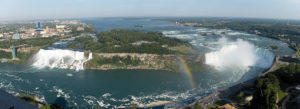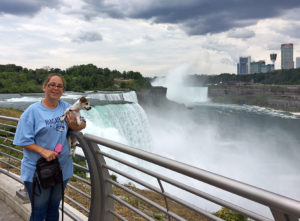The first time I ever saw Niagara Falls was from an airplane flying home to my grandmother’s funeral. The pilot pointed out the Falls below us, and from that height in the air, it looked like it was only a few inches wide. Niagara Falls marks the border between New York and Ontario, Canada, and what a beautiful border, it is. The American Falls is on the American side and Horseshoe Falls is on the Canadian side. To the right of American Falls is a smaller waterfall, that’s been separated by natural forces, that is usually called Bridal Veil Falls.
The fresh water that plunges over Niagara comes from four lakes – Lake Superior, Lake Michigan, Lake Huron, and Lake Erie. One-fifth of the world’s fresh water is found in these four great lakes. Once it travels over the falls, it goes from the Niagara River to Lake Ontario, then to the St. Lawrence River, and eventually to the Atlantic Ocean.
I got to visit Niagara Falls many years later with my friend Bette Garber. She was riding with us in the truck, to get stock photos, and it worked out that our load in Buffalo wouldn’t be ready until midnight. We dropped our trailer and bobtailed to Niagara Falls, NY to spend the day and evening. Parking along a city street was no problem, so we were able to walk and see all the sights.
We took a tour across the border, and I remember seeing the Kodak Tower (now known as the Casino Tower). Back then, we were big supporters of Kodak with all the film we bought! Part of the tour included a trip into the tunnel where a scene from the movie Niagara, starring Marilyn Monroe, was filmed. I remember the rainbows in the mist from the falls, as well as the beauty of the American Falls colorful display at night. I wish we could have booked a ride on the Maid of the Mist (a boat that takes you right to the bottom of the falls). Now, it’s on my bucket list to do one day.
It’s an amazing place to visit and this natural wonder, unlike any other, is rich in history. Niagara Falls goes back thousands of years to the Ice Age, when large torrents of water from the melting ice drained into what is now known as the Niagara River. The water plunges over the edge of the Niagara Escarpment, a steep slope that runs from New York through Ontario, Michigan, Wisconsin, and Illinois. An escarpment is a cliff or steep slope separating two comparatively level or more gently sloping surfaces, resulting from erosion or faulting. Scarp refers to the cliff itself.
Niagara Falls was opened up to throngs of visitors with the development of the rail system in the 1800s. It has been the traditional “Honeymoon Capital of the World” for more than 200 years. Theodosia and Joseph Alston embarked on their “Bridal Tour” with a number of servants and nine pack horses. Passing through the settlement of Buffalo, they came to the cataracts (the Latin word for waterfalls) of Niagara. Theodosia was the daughter of the future Vice President of the United States, Aaron Burr.
In 1804, Napoleon Bonaparte’s younger brother Jerome and his bride, Elizabeth Patterson, honeymooned in Niagara, and thus the social custom of honeymooning at Niagara Falls was born. Back then, only the wealthy could afford a Niagara Falls honeymoon. When the Erie Canal on the U.S. side of the border opened in 1825, the Falls became more accessible to middle-class newlyweds, and before long, the railroad was bringing honeymooners to Niagara on a daily basis.
In 1846, a charter was granted from the State of New York to operate a ferry service across the river, and on May 27th, 1846, the first Maid of the Mist boat was launched. It was a clumsy steamship that ferried people between carriage roads on the New York and Canadian sides. The ferry service was short lived after the completion of the First International Bridge. The Maid of the Mist took up the role of a sightseeing service to remain viable. With upgrades to the boats and several different owners, it has remained viable through all these years. The ride runs every 15 minutes and departs from and returns to the Observation Tower, where guests are given a souvenir rain poncho.
Industrialists who were attracted to the potential power of Niagara Falls would use water wheels to drive their mills and factories. In 1895, the world’s first large-scale hydroelectric generating station opened. This plant used the direct current (DC) system, which could only transmit electricity 100 yards. A year later, electrical engineer Nikola Tesla proved that he could transmit electricity from Niagara Falls to Buffalo, NY, using his new alternating current (AC) induction motor. This marked the first long distance commercial use of the AC system that is still used today.
On August 6, 1918, a near tragedy was averted by three men who opened the dumping hatches of an Iron Scow (a steel barge) to let water in and ground the out-of-control boat. Over 100 years later, the rusty barge still remains where it was stranded that day, in the water, about a thousand feet before the falls.
The Queenston-Chippawa Hydro Electric Development was built between 1917-1925 and was the world’s first true hydroelectric mega-project. It was created by Ontario’s Hydro Electric Power Commission (HEPC) in response to the increasing urban and industrial demands for more electrical power in Toronto and southwestern Ontario. The first unit of the development went into service in 1922. The scale of this huge project presented unique problems and required construction equipment, power conversion units, and a power canal at a size not seen ever before. The site was designated a national historic site of Canada in 1990.
Between the years of 1931 and 1954, rocks fell in the water and natural erosion occurred, which if not prevented, would result in permanent extinction of the Falls. This caused a public outcry and protests to save the American Falls. In June of 1969, the United States Army Corps of Engineers (USACE) was given the immense responsibility of shutting down the flow of water to make repairs. It took three days, working two 11-hour shifts, to build a cofferdam using 1,264 truckloads of earth and sand weighing 27,800 tons. Rochester Shale, a type of rock, began crumbling during the repair project, so they had to work fast. This was a major concern for the geologists who wanted to carry out tests to help prevent further erosion.
When the falls stopped flowing, they found millions of coins and two bodies – one was a man, and the other was a woman who was wearing a gold band with the tragic inscription “forget me not” inside. Some thought this was a surprisingly low number, given the Falls’ history of accidents and suicides. In 1969, Niagara Falls ran dry, man walked on the moon, Sesame Street aired their first season, the Beatles played their last performance together, and Woodstock was held on a farm in Bethel, NY. Wow, what a year! In November of 1969, the cofferdam was destroyed with dynamite, and the massive flow of water over the American Falls resumed.
At night, on the Canadian side, water is diverted from the Niagara River above the Falls by a canal and three tunnels that pass through and under the city of Niagara Falls to the Sir Adam Beck Generating Plants located in Queenston, Ontario. On the American side, water is diverted through tunnels to the Robert Moses Power Generating Plant in Lewiston, NY, downriver of the falls. From November 1 to March 31 (the tourism off-season) another 50,000 cubic feet of water is diverted, reducing the flow of water to about 25% over the Falls. This plan allows the Falls to remain unaffected during prime viewing hours, helps curtail erosion, and allows for more water for power generation.
I want to thank friends who have shared their pictures of seeing Niagara Falls with us. If you haven’t been there, it’s definitely a place worth seeing. Our friends Mike and Norma Gaffin and their family made it a stop on the way to our wedding last July. If you’re a driver and you get near Buffalo, NY with time, go see Niagara Falls. You will not be disappointed by this beautiful border that separates the U.S. and Canada!





